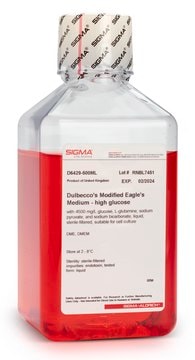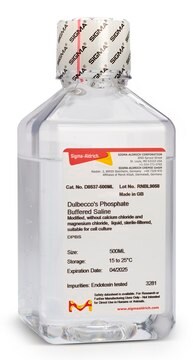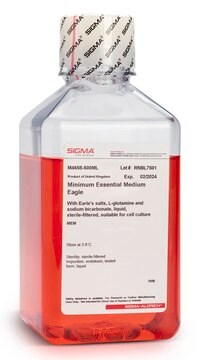This product has not been validated for use with the megakaryoblastic cell line DAMI. However, literature indicates compatibility with this cell line. The following citation may be of interest: PLoS One. 2020 Apr 7;15(4):e0230507.
R8758
RPMI-1640 Medium
With ʟ-glutamine, sodium bicarbonate, liquid, sterile-filtered, suitable for cell culture
Synonym(s):
Roswell Park Memorial Institute 1640 medium
Select a Size
About This Item
Recommended Products
Product Name
RPMI-1640 Medium, With L-glutamine and sodium bicarbonate, liquid, sterile-filtered, suitable for cell culture
Quality Level
sterility
sterile-filtered
form
liquid
technique(s)
cell culture | mammalian: suitable
impurities
endotoxin, tested
components
NaHCO3: yes
phenol red: yes
sodium pyruvate: no
HEPES: no
L-glutamine: yes
shipped in
ambient
storage temp.
2-8°C
Looking for similar products? Visit Product Comparison Guide
General description
Application
also commonly purchased with this product
recommended
Storage Class Code
12 - Non Combustible Liquids
WGK
WGK 1
Flash Point(F)
Not applicable
Flash Point(C)
Not applicable
Regulatory Listings
Regulatory Listings are mainly provided for chemical products. Only limited information can be provided here for non-chemical products. No entry means none of the components are listed. It is the user’s obligation to ensure the safe and legal use of the product.
JAN Code
CR40329-100ML:
R8758PROC:
CR40329-500ML:
R8758-BULK:
R8758-1L:
R8758-500ML-C:
R8758-PH:
R8758-24X500ML:
R8758-100ML:
R8758-500ML:
R8758-2L:
R8758-6X1L:
CR40329-10L:
R8758-3.5L:
R8758-10L:
CR40329-1L:
R8758-VAR:
CR40329-3.5L:
R8758-6X500ML:
Choose from one of the most recent versions:
Already Own This Product?
Find documentation for the products that you have recently purchased in the Document Library.
Customers Also Viewed
Protocols
Preparation for biodegradable nanoparticles and their use in transfection protocols .
Step-by-step protocol for ADCC assays using cryopreserved NK effector cells including tips and tricks, assay development, and data analysis methods.
Learn how to perform cell migration assays in vitro using Millicell® hanging cell culture inserts and the suspension T-cell lines Jurkat and primary CD4+ cells. Monitor migration by flow cytometry and EZ-MTT assays.
Related Content
Learn how to use our cell culture tested, ready-to-use MilliShot™ single dose antibiotic solutions, conveniently packaged in one-time use vials.
Our broad range of the most trusted tools for cell culture includes stringently sourced and tested FBS, established media formulations, and sterile labware. Cutting-edge techniques using stem cells and 3D matrices are enabled by organoids, hydrogels, culture scaffolds, and bioinks for 3D bioprinting.
-
Good Morning, does RPMI medium R8758 which contains sodium bicarbonate, affect cell suspension culture of megakaryoblastic cell line DAMI? I mean, sodium bicarbonate can significantly modify cell behavior or his effects can be tolerated?
1 answer-
Helpful?
-
-
I bought this product and realized that it does not contain Hepes. Can I add hepes?
1 answer-
This product utilizes a bicarbonate buffering system. However, there are no anticipated problems with the addition of HEPES. We do offer RPMI formulations containing both sodium bicarbonate and HEPES, such as Products R5886 & R7638.
Please see the RPMI formulation tables at the link below: https://www.sigmaaldrich.com/deepweb/assets/sigmaaldrich/product/documents/203/777/r8758for.pdf
Helpful?
-
-
Considering that I have to use an RPMI medium containing 4mM of l-Glutamine and 10mM of non-essential amino acids, can I use the product R8748 without adding anything?
1 answer-
The information you are requesting can be supplied by our Technical Service team who can assist you further. We kindly ask you to navigate to the link https://www.sigmaaldrich.com/techservice, and click on "Product Technical Inquires" under the Products Section with all the required information so that a member of our team can reach out to you to assist further. Thank you.
Helpful?
-
-
buenos dias, llevo años usando vuestro producto RPMI 1640, y me gustaría saber la composición del medio para ver si hay algun metal/producto que no puede utilizar con un suplemento que quiero introducir. Muchas gracias
1 answer-
Please see the link below to review the RPMI formulation tables. This product is listed in the second column of page 2:
https://www.sigmaaldrich.com/deepweb/assets/sigmaaldrich/product/documents/203/777/r8758for.pdfHelpful?
-
-
Can Product R8758, RPMI-1640 Medium, be frozen?
1 answer-
We do not recommend freezing cell culture media. A precipitate may form upon thawing. Also, this can cause a loss of amino acids, which may yield low cell growth.
Helpful?
-
-
Does Product R8758, RPMI-1640 Medium, contain HEPES?
1 answer-
There is no HEPES in this formulation of RPMI. We do offer RPMI containing HEPES as Product No's. R5886 and R4130. The formulation of RPMI and other classical media can be found on the Cell Culture Web Page.
Helpful?
-
-
Does Product R8758, RPMI-1640 Medium, contain phenol red?
1 answer-
This media contains phenol red. The formulation of RPMI and other classical media can be found on the Cell Culture Web Page.
Helpful?
-
-
Does Product R8758, RPMI-1640 Medium, contain glucose?
1 answer-
RPMI contains glucose at 2 g/L. The complete formulation of RPMI and other classical media formulations can be found on the Cell Culture Web Page.
Helpful?
-
-
What is the Department of Transportation shipping information for this product?
1 answer-
Transportation information can be found in Section 14 of the product's (M)SDS.To access the shipping information for this material, use the link on the product detail page for the product.
Helpful?
-
-
Can I add the glutamine dipeptide to Product R8758, RPMI-1640 Medium?
1 answer-
This formulation of RPMI already contains L-glutamine at 0.3 g/L. It does not require further supplementation with L-glutamine or the L-glutamine dipeptide (Product No. G8541).
Helpful?
-
Active Filters
Our team of scientists has experience in all areas of research including Life Science, Material Science, Chemical Synthesis, Chromatography, Analytical and many others.
Contact Technical Service







